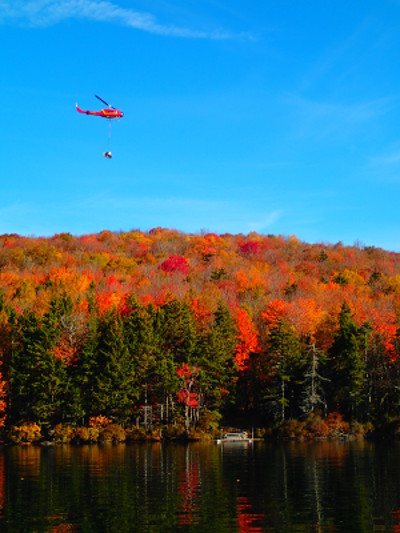Terrestrial Influences on Aquatic Ecosystems: Watershed Liming as a Restoration Practice
Collaborators - Dan Josephson, Tom Daniel & Kurt Jirka (Cornell), Greg Lawrence, Barry Baldigo, Doug Burns & Karen Murray (USGS-Troy NY), Charley Driscoll (Syracuse University)

For the past 12 years we have been examining the recovery of a brook trout population in a 312 ha Adirondack lake subject to extensive acidification for several decades. Cornell University began studies of the Honnedaga lake fishery in the early 1950s, but stopped surveying the lake in the late 1970s when the brook trout population in Honnedaga Lake and its 23 tributaries was considered to be functionally extirpated. The Honnedaga Lake watershed received acidic deposition at high levels for decades due to its its relatively high elevation (660 to 800 m) in the southwestern Adirondack region. However, decreased acid deposition since the 1990s led to improvements in water chemistry and a modest rebound of the brook trout population, which has been designated by the State of New York as one of seven remaining heritage strains of brook trout considered to be genetically unique. In fall 2000 we captured spawning brook trout in the main body of the lake for the first time in two decades, indicating that the lake had been re-colonized from a few well-buffered tributary refuges as in-lake concentrations of sulfate, nitrate, and inorganic monomeric aluminum declined. Nevertheless, the density of brook trout in the lake remains low, and reproduction in most lake tributaries continues to be either prevented or limited by acidification.
The goal of this project is to evaluate the addition of lime directly to two streams and to an entire watershed as an experimental management approach to accelerate recovery by: 1) reducing acidity of soil and surface waters, and 2) increase availability of Ca, a critical ecosystem nutrient.
In July 2012 we and our collaborators limed one episodically acidic Honnedaga lake tributary as an initial step in evaluating liming practices that could provide a practical option for the recovery of acid-sensitive, high-value natural resources. In October 2013 150 tons of high Ca limestone was distributed by helicopter in a pelletized form over a 30 ha watershed with another tributary flowing into Honnedaga Lake; a neighboring watershed will serve as the reference. Lime was also again added directly to two tributary stream channels of Honnedaga Lake (with another tributary serving as the reference) in June 2013 so that effects will be maximized through most of the growing season, and once in March 2014 to evaluate the treatment when flows are typically highest and stream water the most acidic.
For further information:
Josephson, D.C., Robinson, J.M., Chiotti, J.A., and Jirka, K.J. and C.E. Kraft. 2014. Chemical and biological recovery from acid deposition within the Honnedaga Lake watershed, New York, USA. Environmental Monitoring and Assessment 186:4391-4409. [Link to Full article]